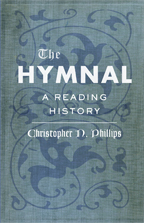Notice of Online Archive
This page is no longer being updated and remains online for informational and historical purposes only. The information is accurate as of the last page update.
For questions about page contents, contact the Communications Division.
The Wall Street Journal reviews book by Chris Phillips, associate professor of English
 During the 18th and 19th centuries, the second-most common book in middle- and working-class households, after the Bible, was a hymnbook. The Hymnal: A Reading History by Chris Phillips, associate professor of English, is “a genuine contribution” to understanding its significance, notes The Wall Street Journal in a Dec. 24 review of the book.
During the 18th and 19th centuries, the second-most common book in middle- and working-class households, after the Bible, was a hymnbook. The Hymnal: A Reading History by Chris Phillips, associate professor of English, is “a genuine contribution” to understanding its significance, notes The Wall Street Journal in a Dec. 24 review of the book.
Before musical notation became prevalent in the 1870s, hymnbooks were small, affordable, and meant to be read, for many owners also serving as notebooks and journals.
“Learning to read from the simple diction of the greatest English hymn-writers—Watts, John Newton, John and Charles Wesley—somehow worked,” states the article, titled “The Hymnal Review: How to Make a Joyful Noise.” “The hymnbooks’ most popular items were anthologized in school readers and spellers, and missionaries and preachers distributed hymnbooks to the poor for the purpose of encouraging literacy.”
The book also received a positive review in August in a Christianity Today article, “What We Lose When Hymnbooks Disappear.”
 During the 18th and 19th centuries, the second-most common book in middle- and working-class households, after the Bible, was a hymnbook.
During the 18th and 19th centuries, the second-most common book in middle- and working-class households, after the Bible, was a hymnbook.